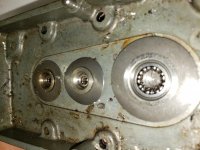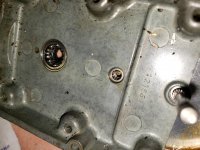Hello, I purchased a trav a dial 6a on ebay very cheap knowing I was probably throwing my money away. I examined it out of the box and saw the knob and track wheel had some axial and radial play. I figures the bearing is shot so I thought no harm in opening it up to tinker. I removed the factory epoxy from the screw holes and opened the unit. I was very surprised at the internal condition. All the bearings were intact and nice and shiny and looked new. Inside of case has very few chips and swarf. The bevel seats on the track wheel shaft are not worn yet when the 2 halves are together that shaft does not make contact with both bearings and therefore the shaft play is introduced.
The top bearing under the knob is pressed into the casting has no adjustment. However the bottom bearing has 2 spring washers between the outer race and the casting which look like they are there to apply preload and take out any wobble in the shaft. That bottom bearing does not move axially and looks like the bearing housing is epoxied to the case. I removed as much epoxy as I could see and I placed the casting in an arbor press and using a round pin about the same diameter as the bearing housing, I tried to press the bearing loose in the casting so the spring washers would apply pressure to the bearing against the shaft. It doesn't want to budge with moderate pressure. I'm afraid to put too much force and ruin it entirely. I also am concerned about heating it and causing damage. Has anyone successfully freed up the bearing? Any other ideas?
Thanks,
Mike.
The top bearing under the knob is pressed into the casting has no adjustment. However the bottom bearing has 2 spring washers between the outer race and the casting which look like they are there to apply preload and take out any wobble in the shaft. That bottom bearing does not move axially and looks like the bearing housing is epoxied to the case. I removed as much epoxy as I could see and I placed the casting in an arbor press and using a round pin about the same diameter as the bearing housing, I tried to press the bearing loose in the casting so the spring washers would apply pressure to the bearing against the shaft. It doesn't want to budge with moderate pressure. I'm afraid to put too much force and ruin it entirely. I also am concerned about heating it and causing damage. Has anyone successfully freed up the bearing? Any other ideas?
Thanks,
Mike.



